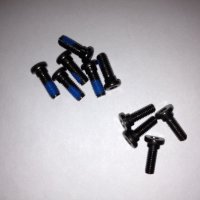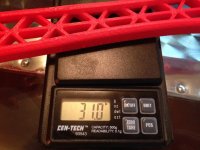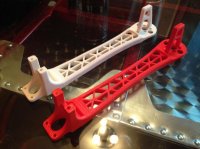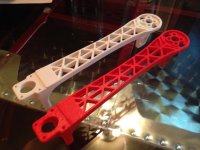You are using an out of date browser. It may not display this or other websites correctly.
You should upgrade or use an alternative browser.
You should upgrade or use an alternative browser.
Aluminum arms for dji flamewheel frames
- Thread starter Maymidroix
- Start date
Jindalee10368
Member
Dumb question, but...
If the aluminum arms transfer the point of failure to the boards, then is it wise to be using thread lock to secure the screws?
I've never used thread lock gunk before, so how much of a problem is it to undo a screw a thread-locked screw, in case you need to do a post-crash board swap?
If the aluminum arms transfer the point of failure to the boards, then is it wise to be using thread lock to secure the screws?
I've never used thread lock gunk before, so how much of a problem is it to undo a screw a thread-locked screw, in case you need to do a post-crash board swap?
econfly
Member
Dumb question, but...
If the aluminum arms transfer the point of failure to the boards, then is it wise to be using thread lock to secure the screws?
I've never used thread lock gunk before, so how much of a problem is it to undo a screw a thread-locked screw, in case you need to do a post-crash board swap?
Blue thread locker (e.g., Loctite 242) allows easy removal. Sometimes you can have an issue with a very small diameter item, but the screws for these arms come out just fine.
In general I think there is too much concern about optimizing crashes. I guess it depends on how people fly. If the goal is to push a cheap quad aggressively, then just build it out of cheap materials. These aluminum arms are best for increasing allowable prop size and making the frame more rigid. That's great for lifting bigger gimbals/cameras and smoothing out some vibrations. But the implication of that is fairly calm flight targeted toward smooth video or nice still photos. The other implication is a rig that costs thousands all-up when you consider gimbal, camera, etc. That means we have a lot more to worry about than an arm if it crashes (mainly the expensive gimbal or camera).
Last edited by a moderator:
Jindalee10368
Member
My (genuine DJI) F450 boards are due to arrive tomorrow.
Already have a set of the Aimdroix arms. :tennis:
This may be a really dumb question, but...
I haven’t ever seen images of washers being used when screwing arms to Flame Wheel boards.
Am I missing something here?
I assume the Flame Wheel boards are just multi-layer fibreglass PCBs.
Over torqueing the M2.5 screws might tend to crush the fibreglass material around the screw heads.
Aimdroix arms are not going to be the first things to give... unlike the captive retainer nuts in the stock plastic arms, which could just pop out.
Should I consider using suitable M2.5 washers (one flat + one shake proof), when fastening DJI boards to these Aimdroix arms?
Already have a set of the Aimdroix arms. :tennis:
This may be a really dumb question, but...
I haven’t ever seen images of washers being used when screwing arms to Flame Wheel boards.
Am I missing something here?
I assume the Flame Wheel boards are just multi-layer fibreglass PCBs.
Over torqueing the M2.5 screws might tend to crush the fibreglass material around the screw heads.
Aimdroix arms are not going to be the first things to give... unlike the captive retainer nuts in the stock plastic arms, which could just pop out.
Should I consider using suitable M2.5 washers (one flat + one shake proof), when fastening DJI boards to these Aimdroix arms?
Last edited by a moderator:
AboveAllAP
Member
Dumb question, but...
If the aluminum arms transfer the point of failure to the boards, then is it wise to be using thread lock to secure the screws?
I've never used thread lock gunk before, so how much of a problem is it to undo a screw a thread-locked screw, in case you need to do a post-crash board swap?
When i first used these arms i used thread lock. Now I dont, very hard to remove. Routine checks on screws but as yet never had a loose one. If i had made it to last meetup you could have checked out my build
Jindalee10368
Member
Anybody???
Washers?
Yes/No?
(not confusing screws coming loose with crushing the boards upon tightening)
Washers?
Yes/No?
(not confusing screws coming loose with crushing the boards upon tightening)
Last edited by a moderator:
Mojave
Member
Anybody???
Washers?
Yes/No?
(not confusing screws coming loose with crushing the boards upon tightening)
I have never used washers on the DJI screws supplied with the Flame Wheel kit; they have a built in spacer (shoulder) that is about the thickness of the printed fiberglass circuit board. The photo below, not my best work, but in a pinch it gives you an idea of this shape. If you order any DJI FW kit you will see that their screws have this unique shape that acts to center the screw and space it so it does not crush the board. Also, each screw tightens to a circle of copper on the board. I believe a washer would be redundant and would keep the screw from setting the board securely. I do use washers on my some of my 3mm screws on occasion, bloody tiny washers that can be a challenge when installing upside down.
View attachment 19376
Attachments
Jindalee10368
Member
Appreciate the info, Mojave.
Good picture.
I didn't purchase a Flame Wheel kit so I don't have the original DJI screws, but ordered some M2.5 x 6 hex screws from ReadyMadeRC at the same as ordering the Aimdroix arms.
These are just generic screws, and don't have the shoulder that yours have.
Good picture.
I didn't purchase a Flame Wheel kit so I don't have the original DJI screws, but ordered some M2.5 x 6 hex screws from ReadyMadeRC at the same as ordering the Aimdroix arms.
These are just generic screws, and don't have the shoulder that yours have.
31 grams arm - DJI 450 / 550 . SUPER LIGHT
3D printed DJi 450 / 550 arms.
-Made of 100% ABS+.
-Durable
-Custom sparse infill dramatically saves weight without sacrificing structural integrity
-Only 31g (standard arm weight 53g). Save a total of 88g (DJI 450) or 132g (DJI 550)!!!
Drone flying is a game of numbers. Use our technology to save your drone 88g-132g, which is about the weight of an iPhone 5!
Now Available in ***********GLOW IN THE DARK***********
Colors include: White, Black, Orange, and Glow in the Dark.



3D printed DJi 450 / 550 arms.
-Made of 100% ABS+.
-Durable
-Custom sparse infill dramatically saves weight without sacrificing structural integrity
-Only 31g (standard arm weight 53g). Save a total of 88g (DJI 450) or 132g (DJI 550)!!!
Drone flying is a game of numbers. Use our technology to save your drone 88g-132g, which is about the weight of an iPhone 5!
Now Available in ***********GLOW IN THE DARK***********
Colors include: White, Black, Orange, and Glow in the Dark.
Attachments
We can get them to you for $65 an arm -- http://www.hollywood3dprinting.com/store/c1/Featured_Products.html -- That's with the threaded inserts. Since we use a sparse infill the plastic is not solid, instead it has a honeycomb like interior. This can only be achieved with the special 3D printing. The arms are still strong, just much lighter. Granted they cost twice as much, but they are almost half the weight...
Our drones are getting longer battery life as a result.
323.645.7640 if you have any immediate questions
Our drones are getting longer battery life as a result.
323.645.7640 if you have any immediate questions
Maymidroix
Member
Those are pretty cool. Will you post the files in thingiverse.com?
Maymidroix
Member
I had a coax set up but it was a real pain in the ***. If you are using the stock motors maybe it's not as bad, but mine were slightly larger and you really had to fight to get that coax setup to work. Would not recommend unless you are using stock dji motors.
They are hard to install if you are using socket button head screws. If you use hex cap head type screw is much easier. http://www.mcmaster.com/#standard-cap-screws/=tm3o1x M3 x 6mm long.
You need to install the arm motor first and then the motor that goes on the coax motor mount plate. The other way to solve this is making a much bigger arm but it will be heavier and cost will be a bit higher.
Maymidroix
Member
I've been working in a new webstore for the aluminum arms. Check it out. http://www.aimdroix.com/store/index.php?route=product/category&path=63




